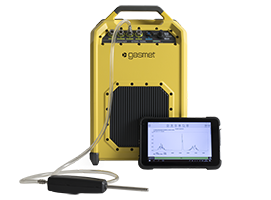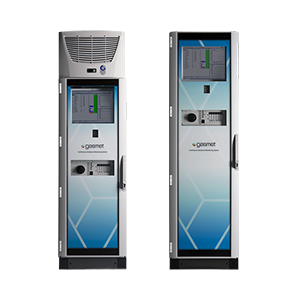In a world increasingly powered by lithium-ion batteries (LIBs), our journey into an electrified future is undeniable in the form of electric vehicles (EVs), electronics, and even energy storage systems. This surge in battery usage has introduced both possibilities and risks. Our eyes are aimed at the very heart of battery safety, where we explore the chain reactions, and toxic gas emissions, and provide the power of early detection with our gas analysis solutions.
Lithium-ion battery thermal runaway
Thermal runaway is like a challenge in a complex puzzle, but we’re equipped with the tools – gas analyzers – to uncover its secrets. These devices are helping us avoid fiery disasters and toxic gas exposures caused by thermal runaway (TR) reactions. This of course involves measuring various gases near the TR source. As different gases are released in different circumstances, heated multi-gas analyzers like the GT6000 Mobilis are essential for accurate measurements and identification. Gases of interest include carbon monoxide, carbonates, acids like hydrogen fluoride, and various VOCs.
Download application note for references in thermal runaway research
Another typical research interest is battery off-gassing. Detecting off-gassing is vital for safety, as it can indicate an upcoming TR. Gases like hydrogen fluoride (HF) and carbonates are used as indicators, often at a 1 ppm threshold.

Lithium-ion battery abuse & people safety
Thermal runaway and battery fires are not just a concern for battery producers but also our brave first responders and unsuspecting EV passengers. Thankfully, we’ve got the ambient gas analyzer GT5000 Terra, which measures gases at the point of exposure when going gets tough and concentrations and temperatures are lower.
Join the webinar: “Lithium-ion battery fires: a practical approach” to hear about a real-life case study showcasing the vital data from a Li-ion battery fire incident.
Type approval of EVs & battery safety
For passenger safety, there are regulations tied to type approval, such as the ECE-R100 framework, followed in Europe, which mandates safe cabin conditions during a TR reaction. Monitoring smaller concentrations of gases like HF, HCl, CO, and VOCs in lower temperatures makes the FTIR technology in GT5000 Terra very suitable for this application.
Battery recycling and manufacturing
Recycling LIBs is driven by regulations to use recycled materials in new battery cells, so it’s like turning trash into treasure, and that’s a big deal. This reduces dependence on the availability of virgin materials as well as offers meaningful second-life applications for end-of-life batteries. Gas analysis is crucial during processes like crushing and solvent recovery. As high gas concentrations are measured, GT6000 Mobilis as a heated system offers a way to characterize these released fumes.
Recycling isn’t just about the environment; it’s also about the workers’ well-being. GT5000 Terra is there to make sure those workers don’t get a whiff of trouble by measuring solvents and compounds in the air.
Lithium-ion battery storage safety
Battery Energy Storage Systems (BESS) are vital for storing renewable energy, from sources like wind or solar power. As a “container full of batteries”, the safety of BESS needs to be ensured. Early and continuous gas detection to avoid gas build-up is required for example in the UK NFPA 855 regulation. This can be achieved with a continuous monitoring of potential off-gasses in the vent systems. For this task, our CEMS II e continuous emissions monitoring system brings unparalleled advantages as it can measure and identify up to 50 gases continuously, including hydrogen fluoride.
Battery-related gas detection is also relevant in logistics and warehousing, where portable GT6000 Mobilis is a more suitable solution to measure potentially hazardous gases.
Want a deeper understanding of the different applications mentioned above and how gas analysis can in help each of those? We recommend reading this article: Gas Analysis – the Cornerstone of Battery Safety Testing
Benefits of multi-gas analyzers for battery safety
Many advantages can be achieved by using multi-gas analyzers. The FTIR technology provides the possibility to measure all gases of interest simultaneously, which is a huge time saver. Results are also available immediately, providing a full picture of these hazardous situations. As there is no need for time-consuming and costly separate sampling and sample treatment, measurements can be performed a lot quicker. This enables more comprehensive surveys of the air quality as a lot more samples can be collected and measured.
The GT5000 Terra and GT6000 Mobilis gas analyzers provide an ideal solution to be used in different battery safety-related applications. Last but not least, these portable instruments are multipurpose and can be used in other air quality and industrial hygiene-related tasks of the facility or for R&D purposes.
Solutions for different use cases
GT6000 Mobilis – heated analyzer
- Thermal runaway research
- Off-gassing
- Battery fire (Research)
- Battery Recycling (crushing and solvent recovery)
- Gas Detection in Logistics and Warehousing
GT5000 Terra – ambient analyzer
- Type approval of EVs
- Battery fire and People safety (First response)
- Battery Recycling (worker safety, industrial hygiene)
- Battery Energy Storage Systems (BESS)
Are you wondering if our solutions can support your needs? Do you have questions related to battery safety gas analysis? Drop your details below and we will get back to you promptly.


